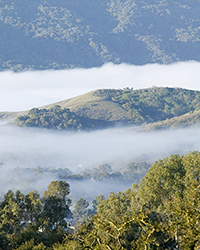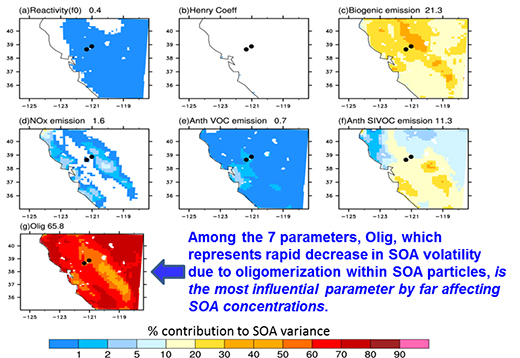Atmospher Sci & Global Chg
Research Highlights
June 2016
Hiding in Plain Sight: A Less-Explored Secret of Secondary Organic Aerosols
The importance of a molecular-bonding process that can improve climate modeling, discovered by PNNL scientists

Pollution and particles blown from cities to the foothills of Sacramento mix with natural emissions from trees and vegetation of the forested region, forming secondary organic aerosols. In this study, scientists found a chemical process that rapidly transforms the composition, volatility, and viscosity of these particles that has until now been missing from their models.
Results: One of the secrets relevant to climate change involves how emissions from nature and human activities are changed in the atmosphere to become secondary organic aerosols (SOA).
Now a team of scientists led by Pacific Northwest National Laboratory has discovered an often ignored but very influential process/parameter that can affect not only the air we breathe but the weather and climate. Oligomerization, or molecular bonding, is a process by which smaller molecules combine and form larger molecules, increasing the amount and lifetime of secondary organic aerosols in the atmosphere. These bondings may hold the key to more successful modeling of the particles. Most atmospheric models ignore oligomerization.
"The study's comprehensive sensitivity analysis clearly shows that leaving out secondary organic aerosol oligomerization processes in climate models could severely limit our ability to understand and predict their impacts," noted Dr. Manish Shrivastava, PNNL atmospheric scientist and lead author of the study. "Our variance-based sensitivity analysis technique shows a lot of promise in ranking the most important processes/parameters producing climate-relevant SOA particles."
Why It Matters: Unseen by the naked eye, large quantities of carbon-containing vapors enter the atmosphere from trees, fossil-fuel burning, and forest fires. Through a complex interaction between sunlight and atmospheric oxidants, these vapors cook an atmospheric stew holding millions of new carbon-containing molecules. Some of these molecules then condense into SOAs that in turn change clouds, influence precipitation, and affect the amount of solar energy reaching the Earth's surface.
Recent measurements led scientists to identify several processes that improve the understanding of how chemically complex SOAs form and persist in the atmosphere. As this understanding evolves, scientists need to determine the most influential parameters/processes affecting SOAs. Ultimately, the most influential must be included in models and long-term climate simulations to better understand the impacts of SOAs on climate change.
In this PNNL study, the scientists found that accounting for a rapid particle-phase oligomerization process in the simulations not only increased the amount of SOA particles, but also affected which sources contributed the most SOAs.
Methods: Researchers from PNNL and the University of California started with real-world measurements from the 2010 Carbonaceous Aerosols and Radiative Effects (CARES) field study. They also included recent laboratory measurements, especially about rapid oligomerization processes affecting the formation and evolution of secondary organic aerosols from both natural and human-made sources. Based on these measurement sets, the team developed a new method to model aerosol particles, which they used in the Weather Research and Forecasting model coupled to chemistry (WRF-Chem). In a first-of-its-kind sensitivity analysis for SOAs, the scientific team looked at how model estimates of SOAs changed when simultaneously varying seven model parameters such as particle-phase oligomerization and precursor chemical emissions that lead to SOA formation. Surprisingly, they found that the oligomerization process was even more influential than the precursor chemical emissions that lead to SOA formation.
When scientists included the oligomerization process in the model, natural vapors wafting from trees proved to be the largest instigator of SOAs in the study area, and model predictions were closer to surface measurements during the CARES 2010 field campaign. Model simulations that neglected this rapid oligomerization predicted much lower SOA particles compared to measurements, and overemphasized the contribution of fossil-fuel emissions in forming SOAs.

Among seven climate model parameters studied, oligomerization, which causes smaller molecules to combine and form larger molecules in secondary organic aerosols, surprisingly proved to be the most influential process affecting SOAs. This process has been neglected in many climate models. Figure courtesy of the author.
Finding influential processes and parameters that control the particle formation is critical to improve climate models and make reliable predictions about impacts on the present and future climate.
What's Next? As process modeling improves, scientists will use comprehensive sensitivity analysis techniques such as the one demonstrated in this study to tease out the secrets and rank the most influential parameters affecting the amount of secondary organic aerosols in the atmosphere. More effectively modeling these influential parameters will help improve the understanding of their impacts.
Acknowledgments
Sponsors: The research was supported by the Department of Energy's (DOE's) Office of Science, Office of Biological and Environmental Research for the Atmospheric System Research program.
Facilities: Scientists performed the simulations at the DOE's Office of Science sponsored National Energy Research Scientific Computer Center using data from the 2010 CARES field campaign and other recent laboratory measurements. They used data collected during the ARM Climate Research Facility's 2010 CARES campaign.
Research Team: ManishKumar Shrivastava, Chun Zhao, Richard Easter, Yun Qian, Alla Zelenyuk-Imre, Jerome Fast, and Ying Liu, PNNL; Qi Zhang from the University of California at Davis; and Alex Guenther from the University of California at Irvine.
Research Area: Climate and Earth Systems Science
Reference: Shrivastava M, C Zhao, RC Easter, Y Qian, A Zelenyuk, JD Fast, Y Liu, Q Zhang, and A Guenther. 2016. "Sensitivity Analysis of Simulated SOA Loadings using a Variance-Based Statistical Approach." Journal of Advances in Modeling Earth Systems 8: 1942-2466. DOI: 101002/2015MS000554
Related Highlights: New Research Nabs #1 Particle Pushers; Crossing the Atmosphere's Next Frontier; Pollution Hitches Ride to Arctic; Following the Aerosol Trail
